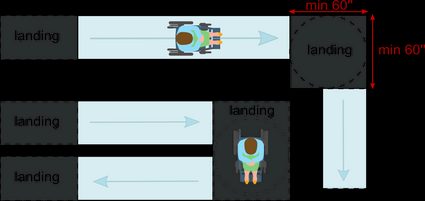

If you're struggling with getting your pushchair 🚼 or wheelchair ♿ up some steps, we've prepared an excellent tool for you — a ramp calculator. Not only can you check the appropriate ramp slope, but we'll give you hints about ramp construction as a whole as well. No need to worry about things like ramp size, landing size, or handrails! If you'd like to know how to build a ramp that complies with ADA ramp requirements, we have included the tips. Also, we recommend reading the detailed ADA ramp slope calculation paragraph below. Are you ready? 🔨
Before we show you how to calculate the slope of a ramp, we first need to explain the slope unit convention. You can express slope in many ways, but let's focus on the three most popular forms:

s l o p e [ r a t i o ] = r i s e : r u n \qquad \mathrm
s l o p e [ a n g l e ] = arctan ( r i s e r u n ) \qquad\footnotesize \mathrm
🙋 Learn more about the inverse tangent function in our arctan calculator!
s l o p e [ % ] = 100 % ⋅ r i s e r u n = 100 % ⋅ tan ( a n g l e ) \qquad\footnotesize\begin
Visit our tangent calculator if you want to learn how to compute the function tan \tan tan .
After that intro on slope units, let's come back to the heart of the matter: how do you calculate the slope of a ramp?

Well, that depends on what information you have - if you know the rise and run (the easiest case), then you can use the formulas mentioned above. However, you might know the rise and the hypotenuse of the right triangle the ramp forms. In this case, you can calculate the run directly from the hypotenuse formula:
r u n 2 + r i s e 2 = h y p o t e n u s e 2 r u n = h y p o t e n u s e 2 − r i s e 2 \begin
In this wheelchair ramp slope calculator, ramp length is the hypotenuse, but for stairs, it will be the stringer length, and for roofing - the rafter length.
Alternatively, you can find the slope using inverse (arc) functions:
s l o p e [ % ] = arcsin ( r i s e h y p o t e n u s e ) \quad\footnotesize\mathrm
s l o p e [ % ] = arccos ( r u n h y p o t e n u s e ) \quad\footnotesize \mathrm
The 2010 ADA Standards (Americans with Disabilities Act) set out some minimum requirements for new public facilities. As well as including many different accessibility standards, it contains guidelines for ramp construction. In this paragraph, we'll take a closer look at ADA ramp slopes.
According to the ADA standards, the least steep slope shall be used for any ramp. Apart from that information, what exactly does the guideline say?



In each case, the maximum rise allowed is 30 i n 30\ \mathrm 30 in ( 760 m m 760\ \mathrm 760 mm ). These three ADA ramp slope values are preset in our ramp calculator.
If existing sites, buildings, and facilities have space limitations, steeper ADA ramp slopes may be permitted. However, stricter restrictions on the maximum rise apply:
75 m m 75\ \mathrm 75 mm
1 : 10 1:10 1 : 10 to < 1 : 12
150 m m 150\ \mathrm 150 mm
Remember that the ADA prohibits slopes steeper than 1:8.
When constructing a ramp, be it for your home, public space, or temporary use, you need to think about a few things other than a ramp slope and rise:
1. Clear width
The minimum clear width of a ramp is 36 i n 36\ \mathrm 36 in ( 91.5 c m 91.5\ \mathrm 91.5 cm ). Don't forget to take into account the mounting of handrails when designing a ramp.
2. Landings
Every ramp should have level landings at the top and bottom of each section - especially if your ramp has multiple sections (turns). The following landing features are essential:


Don't forget to add even more space for switchback ramps.
3. Handrails
Every time a ramp has:
Then the handrails are needed on both sides to comply with ADA standards. You will find more details in paragraph 4.8.5 of the ADA Ramp Document
4. Other important factors are:
If you're wondering how to build a ramp, our ramp calculator will be a great help in its design and construction. Use it as either an ADA ramp slope calculator to meet the government's standards or as a tool to calculate the ramp explicitly tailored to your needs.
Now, how to use this wheelchair ramp slope calculator?
For two ramps of equal length, each should be 23.38 f t 23.38\ \mathrm 23.38 ft long. Of course, you can split it differently, depending on the space available. Just remember that for such a slope, the maximum distance between landing sites is 40 f t 40\ \mathrm 40 ft .
Additionally, you get some tips about landing size and ramp width.
That wasn't so hard, was it?
Moreover, our tool is even more versatile than that, as you can choose the last dropdown option for the ramp application to enter any custom rise-to-run ratio. By selecting that option, you can enter a value for the rise-to-run ratio (e.g., enter 8 8 8 in the field if you need a 1 : 8 1:8 1 : 8 ratio for old buildings) and input a value for the rise. Our tool will then calculate the slope angle, elevation grade, run, and ramp length for you.
We hope that our ramp calculator will be beneficial to you. Rate this calculator and tell us what you think about it and if we can improve it in any way.
To calculate the angle of a ramp:
A 100% slope is one that is 45 degrees above the horizontal. It also has the same horizontal length (run) and vertical length (rise). The following formula explains it:
Inputting our values and rearranging for slope angle gives:
The range of allowed slope for a wheelchair ramp will depend on your local regulation. One of the most famous ones is the ADA Ramp Requirement code. It establishes the following limits:
To build a ramp for a wheelchair: